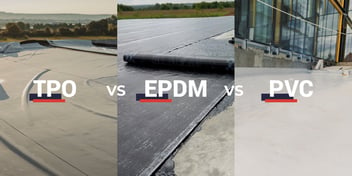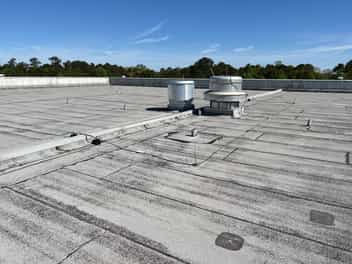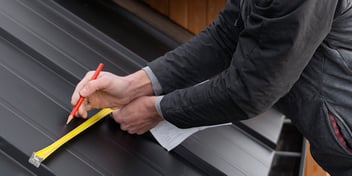- Home »
- Learningcenter »
- Pvc roofing membranes guide
PVC Roofing Membranes: What Is It and Is It a Good Option?
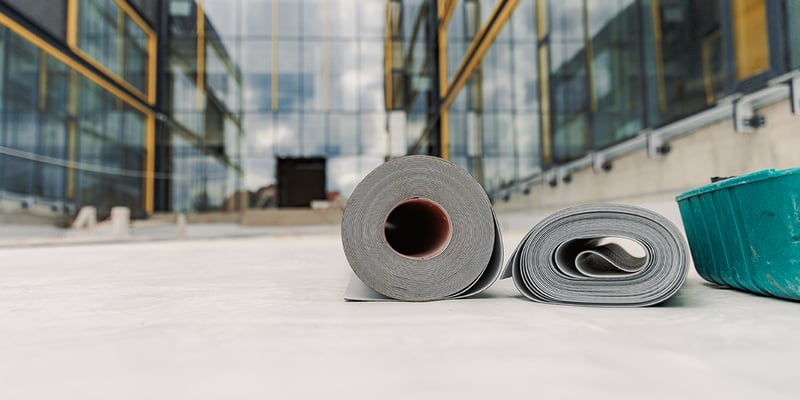
One of the most popular materials for commercial flat roofs is PVC roofing membranes. What is it, though, and is it a good option for your structure?
Made out of two layers of polyvinyl chloride (PVC) and reinforced with polyester in between the layers, PVC membranes can be used as a part of a durable roofing system. Whether or not it’s the right choice for your building, though, will depend on a number of different factors.
For instance, while PVC can be a great choice in places with a lot of sun exposure because of its UV resistance, it doesn’t perform nearly as well in very cold climates. As another example, PVC is suitable for low-slope and flat roofs but isn’t viable for roofs with higher pitches.
In order to determine whether PVC is the right option for you, you’ll want to consider the particulars of your structure and climate and weigh them against the advantages and disadvantages of this material. Let’s look at everything you need about PVC membranes to help you make the best choice for your building.
What Are PVC Roofing Membranes?
Polyvinyl chloride (PVC) is the third most widely produced synthetic polymer of plastic in the entire world. Every year, roughly forty million tons of PVC are produced. Used in countless applications, PVC is used to make drainage pipes, window frames, medical devices, stationery, fashion and footwear, automotive interiors, and– that’s right– roofing membranes.
PVC roofing membranes are a single-ply solution that can be used for both commercial structures and, in some cases, residential homes. Single-ply membranes are sheets of synthetic materials that can be chemically adhered or ballasted to insulation in order to provide a layer of protection. Composed of two layers of PVC with polyester material in between for additional reinforcement, PVC membranes are chemically treated to be resistant to bacteria, heat, fats, and oil, as well as UV stable.
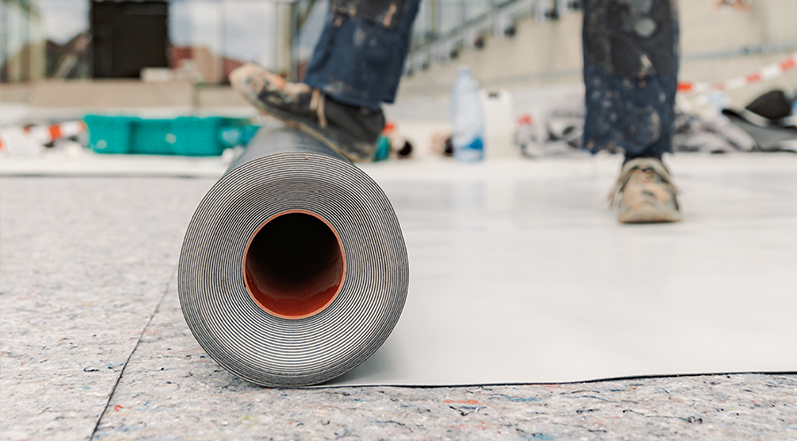
The other two most common types of single-ply membranes are EPDM and TPO.
This is an excellent choice for low-slope applications and flat roofs. For this reason, it’s more common to see PVC roofs on commercial or industrial buildings. In residential usage, PVC membranes can only be used for structures or areas with a low slope, so they are typically seen on covered patios, garages, or flat-roof homes.
When Is a PVC Roofing Membrane a Good Option?
When it’s time to replace your flat roof, deciding what type of material to go with can feel overwhelming. Each roofing system type has its own pros and cons, and how durable and effective they are can involve a myriad of factors, such as the quality of the installation, the climate, the manufacturer you choose, and much more.
However, PVC can be a great choice if you’re interested in investing in a durable, cool roofing system. With a longer lifespan than many other roofing materials, PVC is highly resistant to tears and punctures. If you expect that there will be a lot of foot traffic on your roof, PVC can be a good choice.

Beyond that, PVC is also highly resistant to UV rays. This means that your roof will be better able to withstand the damaging effects of the sun in a climate with lots of sun exposure.
Though TPO is usually considered to be a cheaper roofing solution because its installation cost is lower, over the life of the roof, PVC is typically considered to be the more cost-effective option.
If you’re looking to compare all of the most popular flat roofing options, check out this guide to flat roofing materials.
What Is the Lifespan of PVC Roofing Membrane?
PVC membranes have an average life span of 20 to 30 years. This means that they typically last longer than TPO membranes (which have a 15 to 20-year lifespan) and about the same as EPDM membranes (which have a 20 to 30+ year lifespan.)
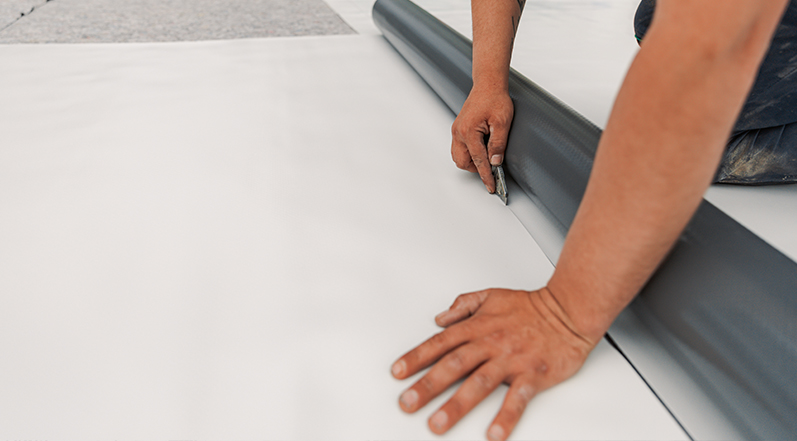
For a comprehensive comparison between TPO and PVC, check out our recent post that compares the pros and cons of these two popular flat roofing materials.
How Can You Extend the Lifespan of PVC Roofing Membranes?
There are a number of different factors that can impact the longevity of a roofing system. Some prominent factors include:
- ● Installation quality
- ● Climate
- ● Type of roofing system
- ● Proper maintenance
- ● Roof penetration
If you want to extend the lifespan of your PVC roof, proper maintenance is absolutely key. With regular inspections, you can catch problems early so they don’t grow into costly headaches.
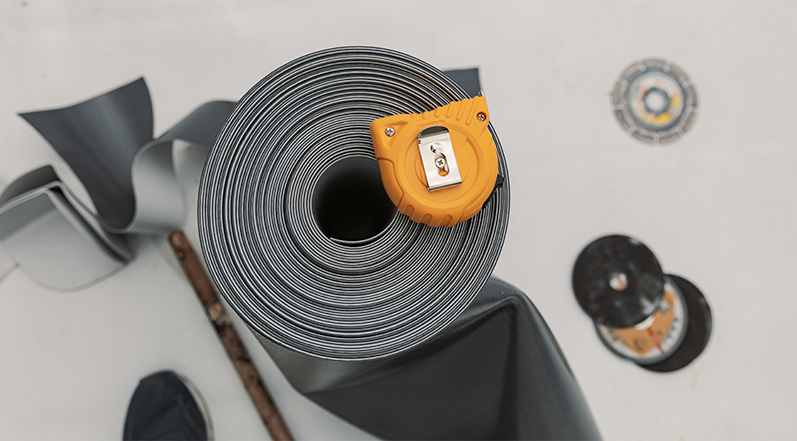
You’ll also want to make sure that nothing impedes proper drainage on your flat roofing system. You can also increase the longevity of the membrane by checking the flashings, seams, and any vulnerable areas after rainstorms and periodically. This way, you can deal with worn areas or damage before water penetration occurs.
You can also use an elastomeric roof coating to help extend the lifespan of your roof.
The Pros of PVC Roofing Membranes
PVC is one of the most popular flat roofing materials for a good reason. Durable, resistant to chemicals and fire, and quick and easy to install, you might find that PVC is the right material to create your cool roofing system.
1. Strong and Durable
One of the major benefits of PVC membranes is that they are highly durable. Most PVC roofs will last for more than two decades, which can mean that you don’t have to worry about replacing your roof for more than twenty years.
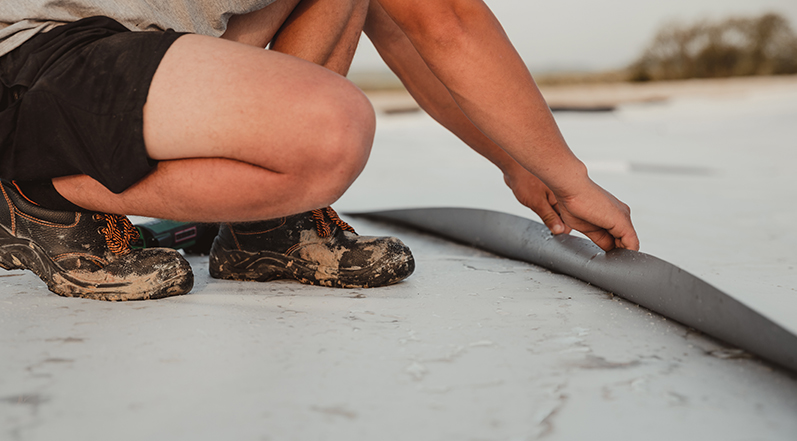
Though there is a required minimum breaking strength of 200 pounds per inch for PVC, according to the American Society of Testing and Materials, many available PVC membranes actually have a much higher minimum breaking strength. This is important because this strength means that your roofing material will be able to withstand the micro movements that accompany harsh, strong winds.
2. Easy to Install
When you’re considering the cost of a roofing project, the two primary concerns are the cost of the materials and the cost of the labor.
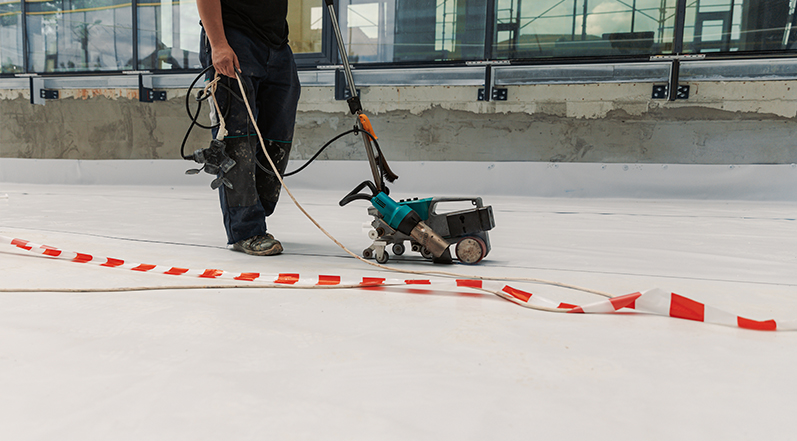
While the total cost of installing a PVC roof might be a bit more expensive than a TPO roof and some other material options, the cost of the entire project is ultimately lower than it could be when you consider how quick and easy to install this material is. Coming in large, lightweight sheets, roofing professionals can move these pieces around with ease and install them relatively quickly compared to other types of material.
3. Resistant to Chemicals
If you are roofing a building that you expect will have lots of exposure to chemicals– whether from your own business or nearby industrial facilities– PVC can be a good choice. Resistant to chemicals, grease, and oils, this is a popular option for hotels and restaurants.
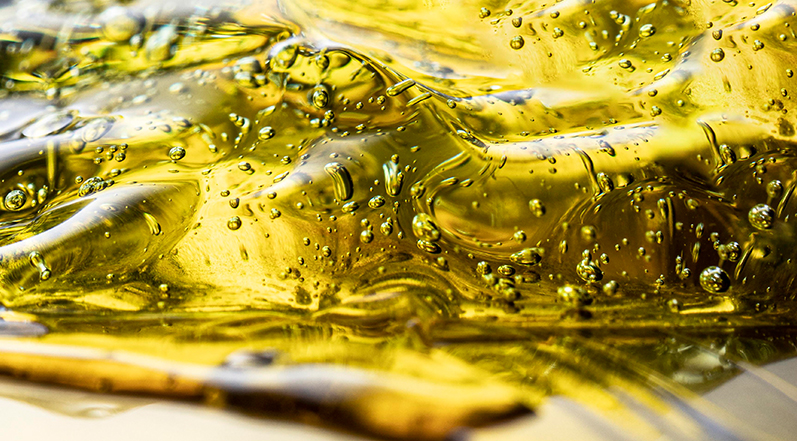
If chemical exposure is a major concern for your structure, you might want to look into PVC-KEE. Resistant to a wide range of solutions and chemicals, this type of single-ply membrane is considered to be the thermoplastic membrane with the best chemical resistance.
4. Fire Resistant
PVC roofs are also highly fire resistant– in fact, thermoplastic PVC is a polymer that is naturally fire resistant. Beyond its inherent ability to resist fire, additional fire retardants are added to PVC roofing membrane formulas.

This means that a PVC roof is very slow to catch or spread a fire. Once the source of flame or heat is no longer present, it is self-extinguishing.
5. Helps Reduce Energy Costs
Another reason PVC roofing is a great choice is that it can help keep your building comfortable and keep cooling costs down in the summer.

These white membranes have high solar reflectivity, which means that you waste less energy, save money, and put less strain on your cooling system.
The Cons of PVC Roofing Membranes
Though PVC has many benefits, that doesn’t mean there aren’t two sides to every coin. PVC isn’t always the best option for all circumstances– for example; it is prone to shattering in areas with significant freeze-thaw cycles and heavy snow.
1. Older Roofs Have More Problems
Though the lifespan of PVC roofs is a hardy 20 or more years, it’s worth understanding that you will likely face additional repairs once the roof gets to be about ten years old.
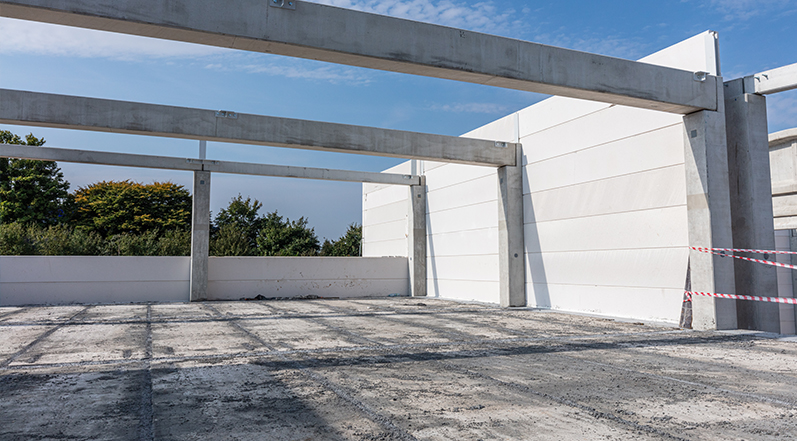
While this shouldn’t be a dealbreaker, you’ll want to take it into account when deciding whether the cost of a PVC roof is worth the longevity. You can reasonably expect that some repairs will be necessary after about a decade.
2. Doesn’t Do As Well in Cold Climates
One of the things you’ll definitely want to consider when choosing a roofing material is the climate conditions that your structure will be subjected to. PVC really isn’t a good choice for cold climates, as cold and icy conditions can cause PVC membranes to shatter.
In order to prevent the entire roof from shattering, a reinforced PVC membrane will need to be used. Even when this reinforced PVC is used, shattering can still occur even though it won’t spread throughout the entire roof surface.

Both EPDM and TPO don’t shatter in the same way in the face of cold weather. If you’re looking for a flat roofing solution in a place with a cold winter, one of these two membrane materials is likely a better option.
3. Cost
Both PVC and TPO roofs tend to be more expensive than EPDM roofs. Between TPO and PVC, PVC is the most expensive option.
That being said, the lifespan of PVC roofs is typically longer than that of a TPO roof. So while the cost might be more upfront, you’ll want to think about the total cost over the lifespan of the roofing material.
Though PVC tends to be more expensive than some of the other options, so many factors impact the cost of a flat roof replacement that it’s difficult to pinpoint a precise price.
4. Shrinking Over Time
As time passes, the PVC membrane will start to pull away from the surrounding walls on the roof because it shrinks over time.
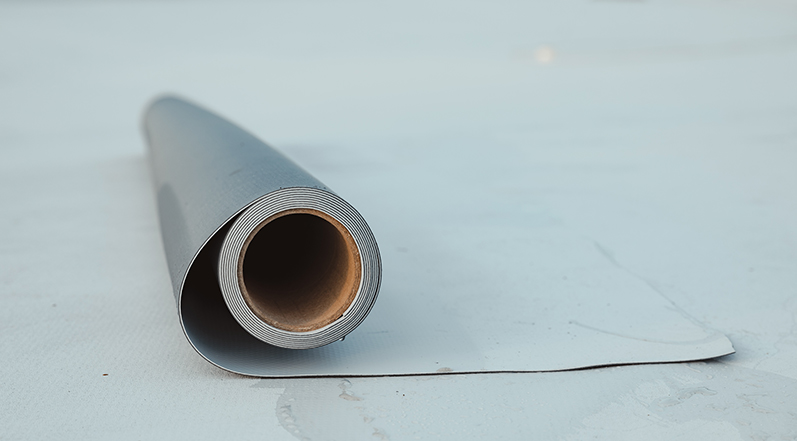
This can lead to leaks and costly repairs in the future if you aren’t attentive to your roof as it nears the end of its life.
5. Repair Challenges
When you’re getting a new roof, it’s easy to overlook considerations about what repairing the roof down the road will look like. However, it’s worth understanding that manufacturers use different formulations to produce PVC membranes. Not all PVC membranes are compatible with one another and won’t always weld to each other.
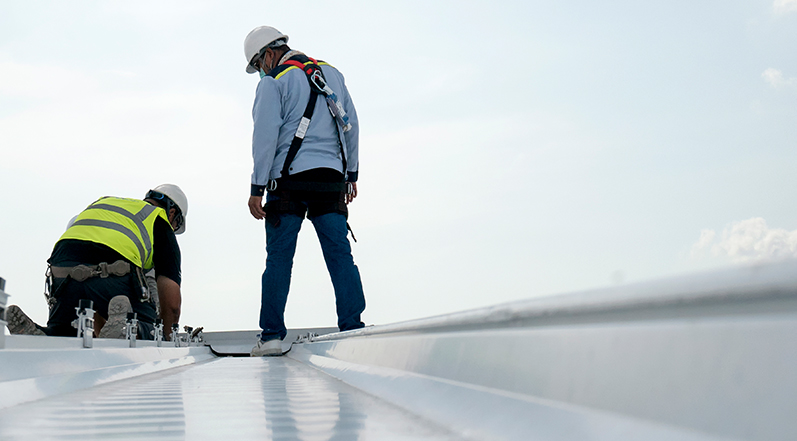
One of the reasons that this is concerning is that there’s always the possibility that a manufacturer will make significant changes to their formula or go out of business during the lifespan of your roof. In these cases, you might simply not be able to find the same material to use for repairs.
PVC also isn’t compatible with many of the self-adhered patching products or peel-and-stick patching products. This isn’t the case for EPDM and TPO. In many cases, the best way to flash or patch a PVC roofing system is to weld it using a PVC that is compatible with the original roofing material.
Is It Time For a New Roof?
There are a lot of decisions to make when you’re installing a new roof, one of which is whether you should use metal, EPDM, TPO, or PVC to protect your structure.
PVC is a very popular choice because it is resistant to chemicals and fire while also being highly durable. It’s lightweight, large sheets are quick and easy to install, and it can be used on various roofing substrates.
On the other hand, you won’t want to use PVC on buildings with steep slopes or in areas that have substantial freeze-thaw cycles or snowfall.

If you’re trying to decide which type of roofing is best for your structure, you’ll want to talk to a professional roofing contractor to get a sense of what your options are. They will be able to help you determine whether PVC is the right choice or if there are other options that are more suitable for your structure.
Are you searching for roofing professionals in the Atlanta area? If so, you’ve come to the right place.
At Colony Roofers, we pride ourselves on providing the highest-quality roofing services at the most affordable prices, all while prioritizing excellent customer service. If you have any questions about your roofing project or would like us to come out to give you a quote, don’t hesitate to contact us today.
 Call (678) 365-3138
Call (678) 365-3138

